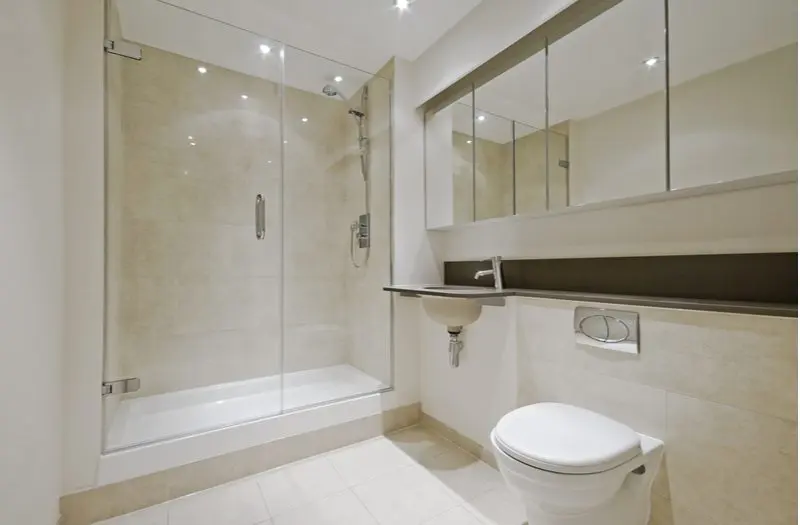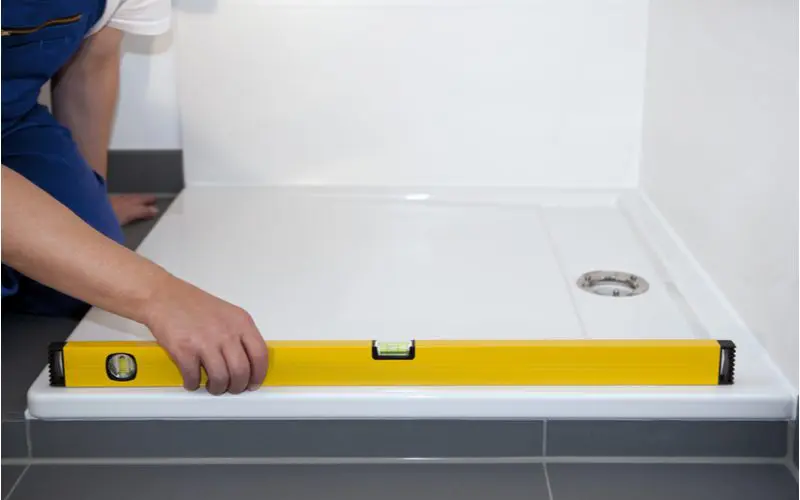If you’re planning a bathroom renovation or building project, it’s essential that you understand building codes.
One code requirement that’s easy to get confused by is the shower door height code.
Codes vary considerably across the country and by the municipality in which you live. They govern all aspects of construction and are the law.
As a result, both professional contractors and do-it-yourself homeowners must abide by them.
But, even though there are some inconsistencies based on the location of a given project, there are also some bedrock rules to remember.
What’s the Minimum Shower Door Height?

Yampi/Shutterstock
Keep in mind that the goal of the shower door is to both prevent water from leaving the shower while it’s in use and also allow easy and safe ingress and egress for those using the shower.
Since we’re all shaped differently and have different skills and movement abilities, the shower door has to accommodate a wide range of potential scenarios.
To figure out the minimum shower door height, you should first determine the type of shower door you will have. Once that’s done, you can look at the average shower doors you might find in a big box store.
This will offer a bit of guidance as to the dimensions required for each type of door. For example, standard pivoted or swinging shower doors are usually 48 inches wide, and they are almost always between 68 and 70 inches tall.
Pivot doors also require enough room and clearance for you to enter and exit the shower compartment. So, the width of the door can’t be so great that it hits obstacles and doesn’t open far enough to allow comfortable entry and exit.
That’s why building codes mandate that there is a minimum of 22” of clear, finished, and unobstructed space for access and egress to the shower.
Standard sliding shower doors are 60 inches in width, and they are usually 79 inches high.
Building a custom shower door is also possible, but the sliding doors you see in stores or online are representative of what’s practical and required for most spaces.
What About Building Codes for Shower Door Heights?

ImageTeam/Shutterstock
Building codes mandate many things. One thing that they do not mandate absolutely is the height of a shower door.
That’s because bathrooms can vary considerably in design.
There are too many ways that doors differ for there to be one guideline for all of them. But there are codes that govern the construction and design of many other aspects of bathrooms.
Shower Dimensions: Width and Length
By code, shower compartments should have at least 900 square inches of interior cross-sectional area.
That area is the inner dimension of the entire shower, not including the fixtures like soap dishes, grab bars, shower heads, or valves.
The shower compartment should also be a minimum of 30 inches, measured from the interior of the finished shower compartment.
To picture this in your head, consider that you should be able to lay a circle with a 30” diameter on the floor of the shower from the centerline of the threshold and without interference from any of the walls.
Some builders just simplify the code by always making sure that the shower has an inner dimension of at least 30 inches in width and 30 inches in length.
That’s an easy way to ensure compliance with the code. But, for comfort, most designers and builders recommend that a shower compartment always have a minimum of 36 inches in length and width.
This accommodation gives people enough room to turn around without bumping into fixtures or becoming uncomfortable. Plus, that’s an easy way to accommodate future add-ons, like safety bars.
Shower Dimensions: Height
Standard rooms in the living area of a house usually require seven feet (84 inches) of height in walking areas.
That means that hallways, bedrooms, kitchens, and even habitable basement spaces must meet the 84-inch minimum.
If you’re wondering about rooms with sloped ceilings, they are legal as long as at least 84 inches of space is present in the room.
For bathrooms, the rules are a bit different. A bathroom or laundry room only requires 80 inches of height to meet the code. When there is a slope in the ceiling, the requirement changes a little to accommodate the slope but still maintains usability.
Tubs and showers equipped with a shower head must have a minimum height of 80 inches over the entirety of the 30-inch by 30-inch area at the shower head. That’s the same minimum size for a shower compartment.
So, if your compartment is only the minimum length and width, it needs a height of 80 inches throughout. Keep in mind that a standard shower head should be 80 inches above the shower floor, but the minimum recommended shower head is 72 inches.
Bathrooms must also have a minimum ceiling height of 80 inches in front of the features. For instance, you can’t have a toilet that’s under a sloped part of the ceiling that’s less than 80 inches tall.
Some of these codes and variations might seem complicated. But, if you think about it, they are only trying to keep designs safe and usable.
Sliding Shower Doors
Sliding shower doors accommodate entry and exit by moving right to left within a track. Typically, the track is on all four sides of the door, fastened to the threshold or edge of the tub at the bottom.
The doors themselves are usually 60 inches in width, and when fully opened, they offer around 21 inches of space for entry and exit in front of the shower.
Since they are surrounded on all four sides by a track and built to standard heights, the top track is about 80 inches tall.
That makes it quite common to find sliding shower doors that are 79 inches high at your local big box stores. That also usually means that the track is lower than the ceiling, and there is some open space at the top.
Pivoting or Swinging Shower Doors
A shower door that opens and closes more like a traditional door is a swinging or pivot shower door. These types of doors are typically 48 inches wide and between 68 and 70 inches tall.
Since they don’t need to fit into a track like a sliding door, they can vary a little bit in terms of placement and overall design. Remember that for a door to open and close smoothly, it will need at least a 16th of an inch buffer around all four of its sides.
Otherwise, the door will be difficult to open and close and may get hung up on the surrounding parts of the shower door.
Shower doors that pivot should always be outward. This prevents a scenario where a person using the shower falls or has an emergency, and rescuers can’t open the door because they are blocking it from swinging.
Types of Building Codes
The International Code Council maintains a compilation of relevant building codes that apply to construction and design in countries around the world. The collection of these codes is often referred to as the International Residential Code (IRC).
But individual countries, states, and municipalities all pile their own requirements on top of the IRC. So, your best resource is almost always the most local codebook or guidance you can find.
That resource will inform you of specific rules in your area. You should contact your local government for instructions about accessing your local code.
You can also look to design organizations like the National Kitchen and Bath Association (NKBA) for best practices in the design of bathrooms.
These are guidelines, not codes. But, while they don’t carry the weight of the law, they can offer a perspective that helps maintain form, function, and safety in bathroom designs.
Other Things to Consider about Shower Door Heights and Code

Andrew Angelov/Shutterstock
Now that you are familiar with shower door height codes, here are a few important things that you may want to consider.
- Showers do not necessarily require a door. Some bathrooms use a curtain in place of a door, while others have open designs with no door at all.
- Bathroom ventilation systems require at least a three-square-foot window, which is 50% operable, or a ducted mechanical ventilation system that can move 50 cubic feet per minute of air to the outside of the structure.
- Shower doors can be as tall as you’d like, but the bigger they are, the heavier they become.
- Standard-height shower doors stop at about 100 inches in height.
- Shower doors are typically between 3/8 inch and 1/2 inch thick.
- Shower doors can be clear, frosted, or completely opaque.
- A toilet or cabinet must not block the space in front of the shower entrance.
- Grab bars should be placed at a height of at least 33 inches, but they aren’t governed by code.
Shower Door Frequently Asked Questions
Some questions about shower door height codes are pretty common. We’ve answered these in detail below:
How Tall Should a Shower Door Be?
A standard shower door is usually between 72 and 96 inches tall. Designs can vary, but that range is most common.
However, you can order custom shower doors in a variety of styles for special projects or to fit a non-traditional space.
How Short Can a Shower Door Be?
A shower door can technically be as short as you want it to be. In fact, you don’t even need to have a shower door at all. Some modern designs are entirely open.
But, you want to account for that in your overall design, so you don’t create a slippery floor and a dangerous condition in the bathroom.
Should the Shower Door Be Higher Than the Shower Head?
The height of the door isn’t regulated by code. But, the shower head’s height should be at least 72 inches, and 80 inches is standard.
Designs differ, but if you have a door in the shower, it should be high enough to prevent most of the water from escaping the compartment when it’s closed.
How Much Space Should Be Between the Shower Door and Ceiling?
Most builders leave about a foot of clearance between the shower enclosure’s door and the ceiling.
This allows steam to escape the compartment during use and also promotes drying of the shower space and prevents excess humidity from lingering in between uses.
Should a Bathroom Door Open Out or In?
For privacy, safety, and odor control, almost all bathroom doors swing inward. Plus, this way, the walking space outside of them isn’t blocked by an opening door.
But swinging shower doors always swing outwardly. Otherwise, if someone fell in the shower compartment, they could stop the door from opening and become trapped.
So, What’s the Shower Door Height Code?
The ICC mandates building codes, and it’s paramount to follow these requirements to ensure the safety of building occupants.
Therefore, the shower door height should be no less than 70 inches above the shower drain outlet. But there is not a mandatory minimum shower door height.

